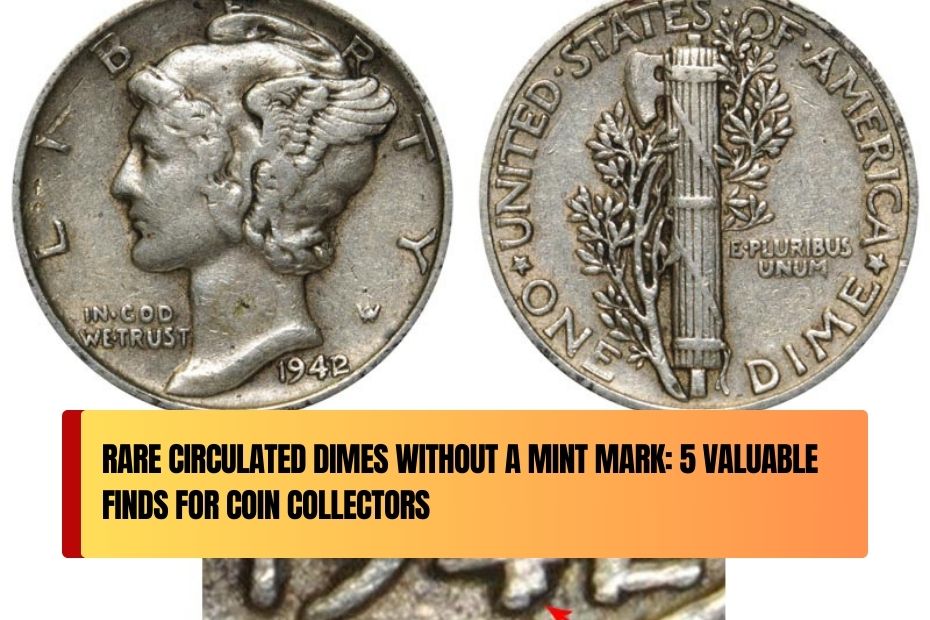When it comes to coin collecting, certain dimes stand out because they were made without a mint mark. Most U.S. coins have a small letter to show where they were made, like “D” for Denver or “S” for San Francisco. However, some dimes were made without any mint mark, which can make them extra special and valuable to collectors. In this article, we will explore five rare circulated dimes that don’t have a mint mark and why they are so valuable.
What Is a Mint Mark and Why Does It Matter?
A mint mark is a small letter stamped onto coins to show where they were made. For example, “P” stands for Philadelphia, “D” for Denver, and “S” for San Francisco. Coins made in Philadelphia, however, didn’t always carry a mint mark. When a coin doesn’t have a mint mark, it can be rare, and in some cases, that rarity can make the coin much more valuable.
5 Rare Circulated Dimes Without a Mint Mark
Here are five dimes made without a mint mark that collectors search for, along with details about their rarity and value:
| Coin | Year | Why It’s Rare | Value Range |
|---|---|---|---|
| 1916 Mercury Dime | 1916 | Made at the Philadelphia Mint without a mint mark. This coin is very scarce and highly sought after. | $500 to $1,000+ depending on condition. |
| 1921 Mercury Dime | 1921 | Produced in Philadelphia with no mint mark, making it one of the rarer years for Mercury dimes. | $50 to $500 depending on condition. |
| 1942 Mercury Dime | 1942 | The last year of the Mercury Dime design, made in Philadelphia without a mint mark. | $5 to $50 depending on condition. |
| 1945-W War Time Silver Dime | 1945 | Some 1945 War Time dimes were struck without a mint mark, which makes them very rare and valuable. | $10 to $100, depending on condition. |
| 1982 Dime | 1982 | Most 1982 dimes have a “P” mint mark, but some were struck without one, making them rare. | $5 to $10 for a well-maintained coin. |
How to Spot a Rare Dime Without a Mint Mark
Finding a rare dime without a mint mark can be exciting, but how do you know if your dime is one of these valuable coins? Here are some steps to help you check:
- Examine the Reverse: The mint mark is usually located on the back (reverse) of the coin. If it’s missing, you could have a rare coin.
- Look at the Year: Certain years, such as 1916, 1921, and 1945, are well-known for being rare when minted without a mint mark. Double-check the year carefully.
- Assess the Condition: The value of a coin is highly dependent on its condition. Coins in excellent condition are worth more, so be sure to look for any signs of wear or damage.
Where to Sell or Trade Rare Dimes Without a Mint Mark
If you discover that you have one of these rare dimes, you might be wondering where to sell or trade it. Here are some common places to consider:
- Coin Dealers: Many coin dealers are experts in rare coins and would be happy to evaluate your coin.
- Online Marketplaces: Websites like eBay allow you to auction or sell your coin to collectors directly.
- Coin Shows: Attending a coin show gives you the opportunity to meet buyers and collectors who are looking for rare coins.
Conclusion
Rare circulated dimes without a mint mark can be a treasure for coin collectors. The 1916 and 1921 Mercury Dimes, in particular, are highly valuable due to their low production numbers and historical significance. If you find a dime without a mint mark, it’s worth taking a closer look. With a bit of research and care, you may have a valuable coin in your hands!
FAQ’s
What makes a dime without a mint mark valuable?
A dime without a mint mark can be rare if it was made during specific years or as part of a limited production. These dimes are often sought after by collectors due to their scarcity and the potential for higher value.
How do I know if my dime is missing a mint mark?
To check if your dime is missing a mint mark, look at the reverse (back) of the coin. Mint marks are usually located near the bottom, to the left or right of the coin’s design. If there is no mint mark, it could be a rare coin.
Where can I sell rare dimes without a mint mark?
You can sell rare dimes through online auction sites like eBay, at local coin shops, or at coin shows. Be sure to get your coin appraised to know its value before selling it.

